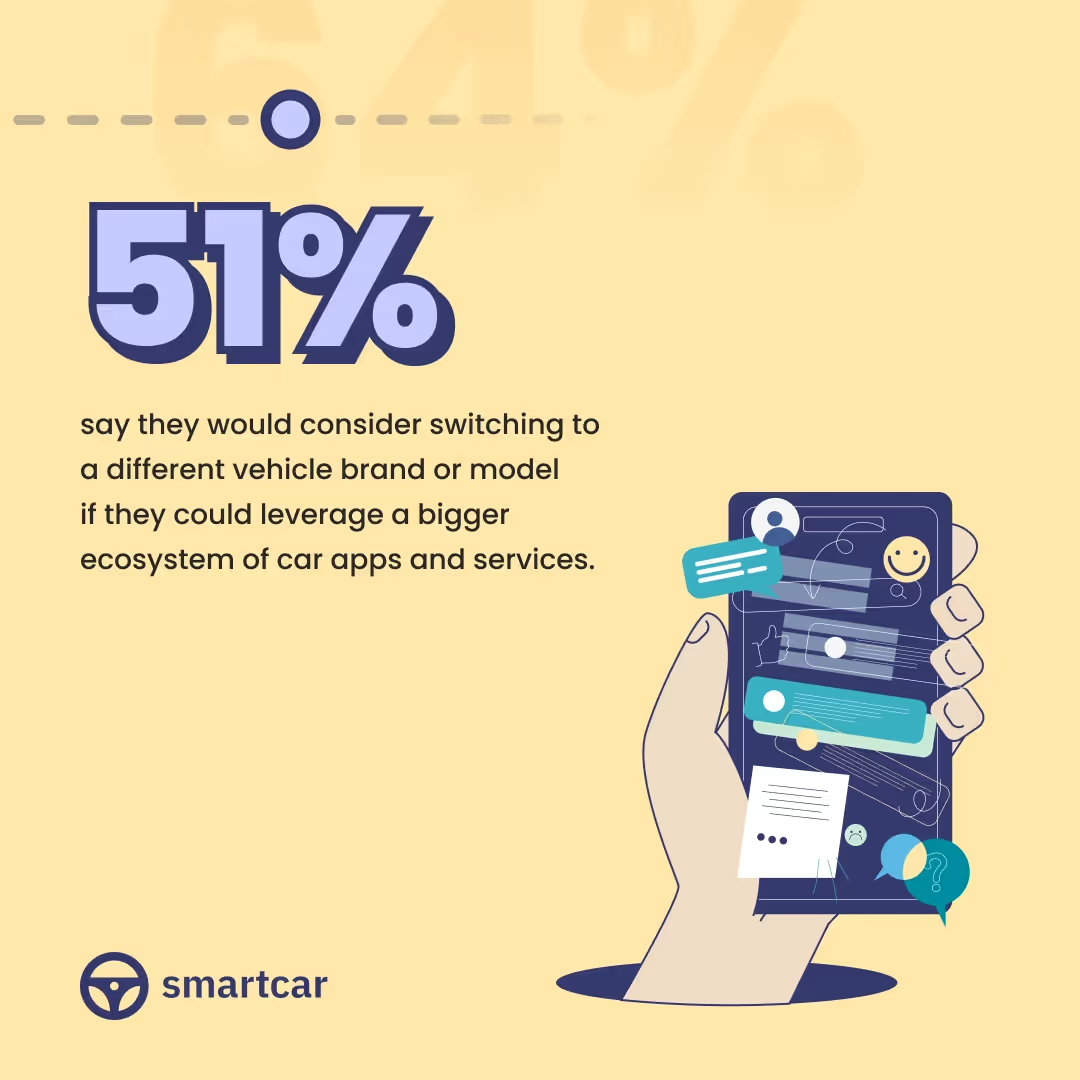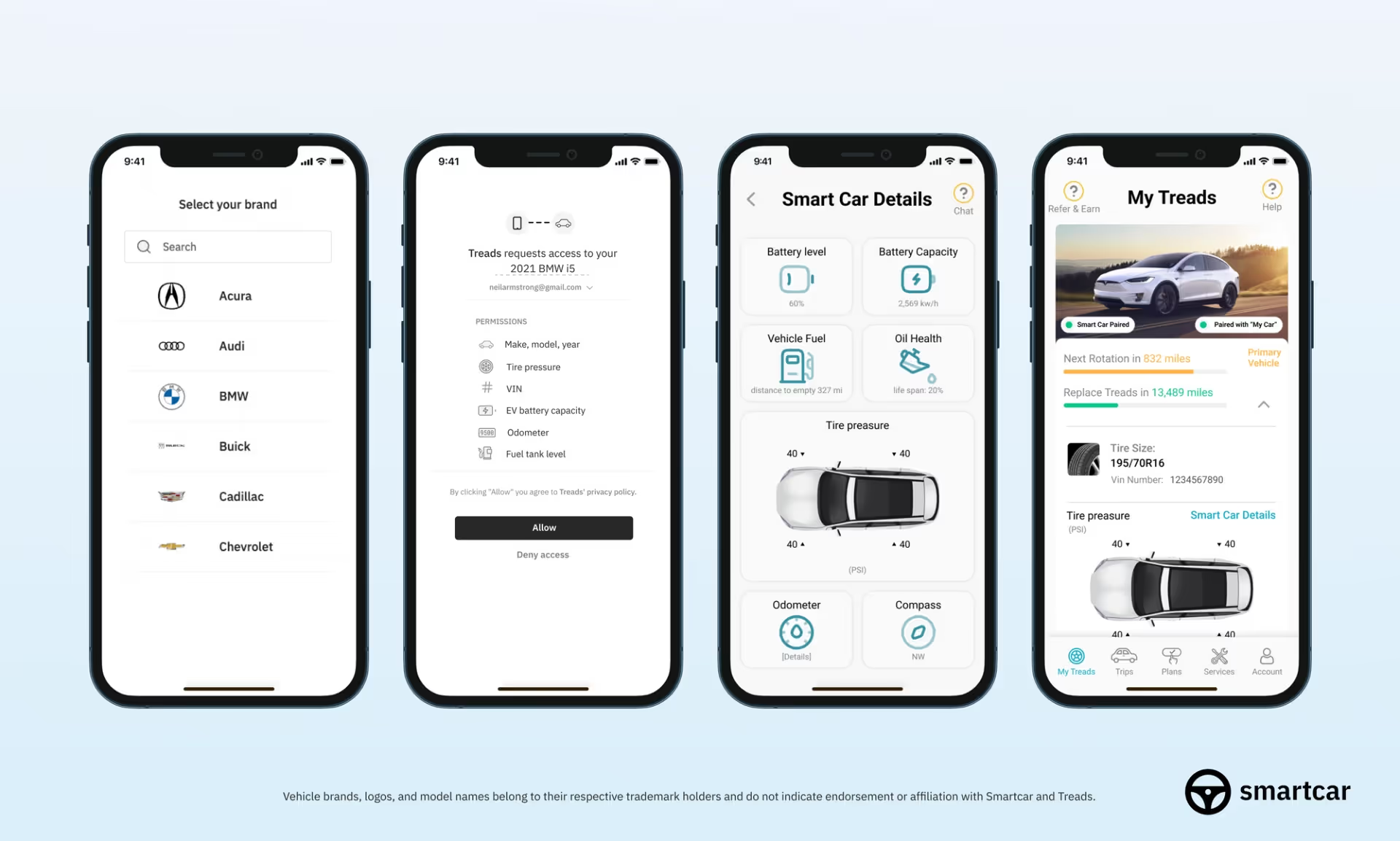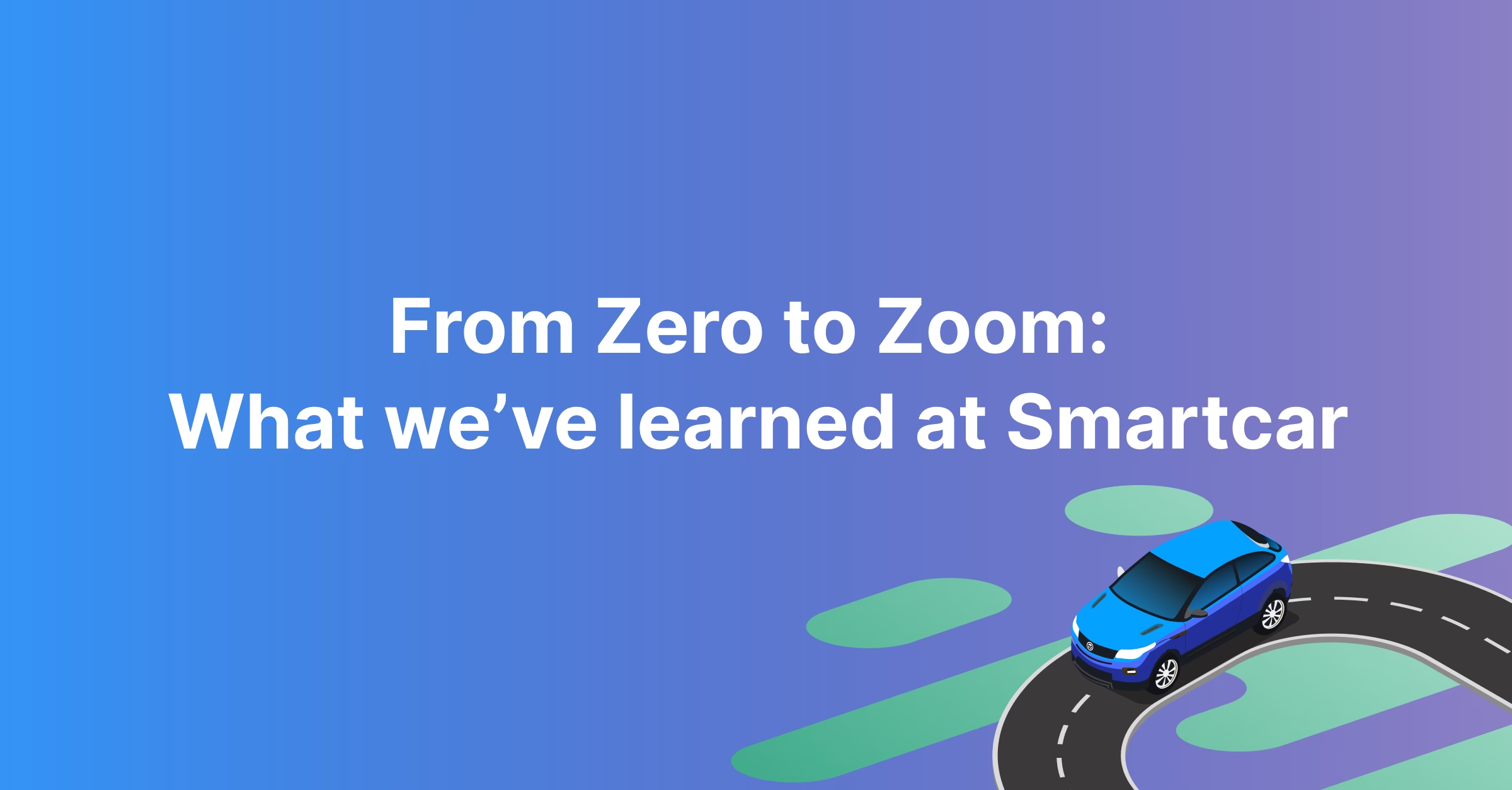The connected car market has grown exponentially in recent years, driven by the promise of enhanced safety, convenience, and a more connected driving experience.
Yet, as automakers push to capitalize on connected car data, they face significant challenges in meeting profit expectations. This blog delves into the intricacies of connected car technology, exploring its definition, impact, and the hurdles it must overcome to fulfill its potential in our evolving transportation ecosystem.
The global connected car market reached $84.9 billion in 2023 and is expected to triple in size over the next decade.
But, despite these advancements, car manufacturers have only generated about $6 billion in revenue from connected services, far below the projected $200 billion. Does this mean that we’re not ready for connected car technology? Not at all.
In fact, it indicates a gap in awareness of what it is and its impact on everyday mobility experiences.
The amount and pace of innovation in connected car technology hasn’t kept up with the industry standard — which everyone compares to their smartphone that is always getting better. If automotive telematics platforms aren't able to even approach that level of innovation and pace of change, it's viewed as underwhelming. That’s a perception we'd like to find a way to change in the market.
— Dan Teeter, Director of Partnerships at Smartcar | Read the blog
In this blog, we explore how connected car technology works, common misconceptions, and how it can challenge our transportation systems for the better.
What is connected car technology?
Connected car technology enables connected cars (cars with built-in internet connectivity) to communicate with other cars and internet-connected devices. These devices can include roadside sensors, smart home systems, parking meters, toll booths, EV charging stations, and mobile or web applications. By communicating with these devices, connected car technology enables drivers and fleet operators to share and access real-time data to power all kinds of actions.
You can use connected car technology to:
- Improve road navigation systems: Get live traffic updates from roadside sensors to avoid congestion. Most newer vehicles come with advanced navigation systems that use traffic data to give drivers real-time route recommendations and enhance traffic safety. These capabilities are included in an automaker’s connected services subscription.
- Streamline road tax payments: Many smart booths today simplify toll payments with devices using radio frequency identification (RFID) technology. Today, transportation departments can use connected car technology to enable automatic mileage verification for equitable road usage charge programs.
- Optimize EV charging: Drivers can connect their vehicle to EV charging applications that use live battery data to find nearby charging stations, schedule charging sessions, enroll in demand response programs, plan routes, and more.
- Monitor vehicle health: Auto care shops and auto dealerships use vehicle connectivity to simplify vehicle maintenance for customers through digital apps and portals. Drivers connect their car to an application to receive maintenance alerts, access vehicle reports,
- Enable smart home features: Drivers can control home devices like thermostats or garage doors remotely from their car for added convenience. With smart home energy management systems, vehicle connectivity allows drivers to schedule charging sessions and automatically optimize sessions for lower energy rates.
- Access emergency assistance: Drivers can request emergency services or roadside assistance through a mobile application if an accident or vehicle breakdown happens. With vehicle connectivity, emergency services can be dispatched directly to a car’s location or be given digital car keys.
Are autonomous vehicles and connected vehicles the same?
These terms are often used interchangeably, primarily because they’re often mistaken to mean the same thing. But the two concepts are distinct, although they do contribute to the same vision of mobility systems communicating more effectively with their surroundings.
Autonomous vehicles (like Waymo and Cruise) are designed to operate without humans. These vehicles use sensors, AI, and advanced algorithms to analyze the environment around them and respond appropriately.
On the other hand, connected vehicles refer to all vehicles with internet connectivity. A majority of vehicles manufactured after 2015 have these capabilities. In fact, 9 out of 10 cars on the road in the US are connected, while almost all EVs have built-in internet connection to power vehicle telematics.
Connected vehicles are not self-driving cars. On the contrary, they’re the vehicles we see and use daily. Unlike autonomous vehicles that need sophisticated hardware and software to communicate with external systems and operate independently, communication between connected vehicles and external systems is led by drivers and consumers.
What types of connected car technology are there?
Discussions around connected car technology typically revolve around the following categories:
- Vehicle to Vehicle (V2V): Allows communication between connected vehicles to share data such as speed and road conditions. This technology vehicles coordinate how cars are moving in traffic or at intersections to avoid collisions. It can also help drivers detect blind spots, assist with lane changes, and more.
- Vehicle to Pedestrian (V2P): Allows communication between vehicles and pedestrians. V2P technology has been piloted by automakers like Ford and Audi in urban areas with high pedestrian traffic to prevent accidents. Vehicles are alerted if pedestrians step into their path, while pedestrians with supported smartphones may receive alerts if a vehicle is approaching them.
- Vehicle to Infrastructure (V2I): Allows communication between vehicles and transportation infrastructure like traffic lights and roads. The aim of this technology is to improve traffic flow, avoid congestion, and increase road safety. For example, Audi piloted this technology in several US cities to minimize stop-and-go driving by allowing Audi connected cars to communicate with smart traffic lights.
- Vehicle to Cloud (V2C): Allows communication between connected cars and cloud-based applications and services. This technology powers the Smartcar API and application ecosystem! Connected cars use V2C connectivity to receive over-the-air software updates and exchange data securely with mobility solutions so drivers can optimize their transportation experience.
- Vehicle to Everything (V2X): Encompasses all the vehicle communication methods mentioned above. As the name implies, V2X allows vehicles to communicate with the entire mobility ecosystem — from people to infrastructure and applications. The goal of V2X pilots and initiatives is to build a fully integrated transportation system that can use automation and data-driven decision-making for more road safety, sustainability, and convenience.
The importance of interoperability in connected car technology
We often hear how V2X technology is seen as the pinnacle of connected car interoperability with the broader connected car ecosystem. But that’s not the only way to integrate connected car technology into different mobility systems.
We’ve covered this before in another blog discussing the role of vehicle connectivity in automotive interoperability — to put it simply, there are ways to facilitate the seamless exchange of data between different mobility systems without V2X technology. What we need is an environment that allows for data standardization across vehicle brands. This allows consumer, irrespective of the vehicle they drive, to use a mix of services and applications that match their preferences.
Transportation departments around the globe have piloted V2X programs to boost road safety, reduce traffic congestion, improve traffic conditions, and facilitate faster emergency response. However, the missing gap here has been the dependency on reliable communication with smart infrastructure. Although this continues to be a work in progress, it doesn’t have to be a barrier to embracing connected car technology.
In fact, there are many use cases and services that can’t be powered by V2X technology and instead require active participation and engagement from drivers.
The potential of connected car technology can still very much be realized today with connected car applications. These applications use vehicle connectivity to seamless access to repair services, improve route planning, enable better energy management for electric vehicles, and more.
Interoperability is also displayed in the ability of drivers to securely connect their vehicles to applications that optimize different aspects of their mobility experience.

Source: Smartcar's 2023 State of Connected Car Apps report
Addressing major concerns surrounding connected car technology
But like all things that are new and unfamiliar, it can sometimes challenge existing processes and habits in ways that are hard to understand. Connected car technology is a relatively new chapter in the automotive industry's long history. For automakers and automobility businesses, it can be challenging to navigate the intersection of connected car innovation, consumer expectations, and evolving regulations.
The following concerns have emerged in recent years largely because the role and impact of connected car technology have been hard to grasp.
Data privacy and security
Investments into software-driven vehicle must go hand-in-hand with investments into more robust security measures for automaker web portals, consent management systems, network monitoring infrastructure, consumer education, and more. On top of that, regulators in North America and Europe are evolving data privacy laws to include vehicle data protection. Automakers and mobility businesses will be mandated to prioritize data transparency for drivers and upgrade existing systems to safeguard vehicle data from breaches.
Network coverage
Connected car technology relies on cellular networks to operate optimally. There are valid concerns that areas with poor coverage will continue to experience limited benefits of connected car technology. However, unlike previous generations of cellular network technology, 5G networks are being rolled out with a clear acknowledgement that vehicle connectivity is a core area of focus. Over the coming years, 5G will expand network coverage, provide higher data speeds, and improve low latency to improve the reliability of connected car technology.
Job security
With connected cars being misunderstood as self-driving vehicles, many associate vehicle connectivity with job displacement. The impact of job security in the era of autonomous vehicles is a big discussion encompassing the economic impact of autonomous investment, government intervention, policy, and initiatives led by the automotive industry. However, vehicle connectivity and autonomous vehicles will both contribute to the creation of new jobs and the upskilling of existing workers. This evolution in jobs and job training will reflect a similar industry response as the manufacturing and financial industry with the rise of automation, robotics, and open banking.
Data standardization
For connected car technology to be interoperable with different devices, applications, and services, mobility businesses must be able to cut through the sheer volume of data generated by vehicles. A lot of this data isn’t going to be useful for any particular use cases, and they must also be standardized across different brands for consumers to be able to access a solution regardless of the vehicle they drive. Standardizing vehicle integrations for mobility applications is exactly what Smartcar does to help build a more holistic and secure ecosystem of mobility apps. Our goal is to make it easier for developers to scale their solutions to as many drivers as possible, and to empower drivers with the option to access an automotive product or service without being limited by the type of vehicle they drive.
Connected car technology challenges transportation systems to do better
Warren Logan, former Oakland Policy Director of Transportation and Government Affairs, discussed sustainable mobility with Smartcar and shared that he envisions the intersection of mobility and technology to expect more from our transportation systems.
“I think that the entrance of tech companies into the mobility space has, for the better, really pushed government, private actors, and everyday citizens to rethink how we make transportation decisions, our mobility options, access outcomes, and so on,” he says.
The maturity of connected car technology and application development helps consumers, governments, and mobility businesses reimagine the solutions that drive our current transportation system. Here are a few ways how connected car innovation shines new perspectives on existing shortcomings:
Sustainability
Our current transportation infrastructure and habits are largely built around gas-powered vehicles. Transitioning to lower-emission vehicles requires not just new manufacturing processes but also a shift in consumer behavior. Connected car applications helps bridge the user experience gap in sustainable mobility and unlock new opportunities for transportation beyond personal vehicle ownership.
Apps in action: EV rideshare

Research by Lyft discovered that customers who have used an EV on rideshare trips are 38% more likely to purchase one for private use.
Rideshare companies like Lyft and Uber use vehicle connectivity to gain insight into an EV’s battery level for automatic ride assignments within a driver’s range. This simple change in the app experience makes it easier than ever to eliminate concerns about range anxiety for rideshare — which has become a big deterrent in decarbonizing rideshare fleets.
“Now, our drivers can take on rides without constantly worrying about their battery levels. It's a game-changer that helps them focus on what they do best – providing great rides for people who need them,” says Ciaro Chow, product manager at Lyft, in a press release with announcing Smartcar and Lyft’s partnership.
Safety
Newer vehicles do come with advanced safety features, but they also unlock more opportunities to actually stay on top of their maintenance schedules. Mechanical issues in vehicles do contribute to accidents. Past research by the National Highway Traffic Safety Administration discovered that 2% of examined crashes were caused by vehicle-related issues like faulty tires, breaks, and engines.
Although this may sound like a small percentage, it adds up to tens of thousands of avoidable injuries. Connected cars make it easier for drivers to gain visibility into their vehicle health, set up predictive alerts for vehicle issues, and schedule vehicle appointments faster. Businesses can also use connected car technology to integrate roadside assistance and emergency services capabilities into their mobile applications, contributing to overall road safety.
Apps in action: Tire maintenance for vehicle owners

Data from the National Motor Vehicle Crash Causation Survey found that 9% of car crashes they examined involved a vehicle with pre-crash tire problems. Another piece of research also found that every year, tire-related passenger vehicle crashes result in about 19,000 injuries every year.
Treads is an app that bundles vehicle maintenance services like tires, alignments, oil changes, and wiper blade replacements into a single application that drivers access with a monthly subscription fee. This monthly subscription model breaks vehicle maintenance expenses down into smaller amounts while helping drivers stay accountable for vehicle servicing. while streamlining the process of scheduling services on demand right from the Treads app.
Affordability
Owning and maintaining vehicles has never been more expensive. Connected car technology introduces new options for vehicle and fleet owners to optimize costs through capabilities like pay-per-mile financing, usage-based insurance, subscription-based vehicle maintenance, or improved vehicle trade-in recommendations based on performance data.
Apps in action: Pay-per-mile financing for fleet operators
Only 1.5% of global fleets — over 12 million vehicles — are made up electric vehicles. Fleet electrification is top of mind for governments globally to reach decarbonization targets. But the higher purchase price of EVs and a lack of visibility into battery health makes the cost of electrification daunting for many operators.
Zeti uses vehicle connectivity to retrieve mileage data from EVs and to generate mileage-based billing for their customers. This billing system is especially valuable for fleet operators with variable fleet usage who are often challenged financially by traditional leasing models.
Privacy
As vehicle connectivity increases, so have discussions about data privacy. Connected car technology has encouraged drivers, automakers and mobility businesses to rethink how vehicle owners access and make choices with their vehicle data. There is increasing scrutiny over how vehicle data sharing is communicated with customers, with drivers expressing their concern over traditional data-sharing models that involve selling automotive data without explicit driver consent. Today, legislation like the American Privacy Rights Act (APRA) and the European Union’s Data Act will require mobility businesses to give consumers more explicit control over data sharing rights and opt-in and opt-out processes.
What can we expect from the future of connected car technology?
Looking ahead, the future of connected car technology will be shaped by several key factors:
- The rollout of 5G technology
- An interoperable standard for connected car integrations
- Mutual collaboration between automakers and mobility innovators
- Clearly defined privacy laws and requirements for consent management
- Government investment in pilot programs for V2X technology
As we move forward, connected car technology will continue to challenge and transform our transportation system — and at Smartcar, we’re excited to empower mobility innovators with developer tools to build on their great ideas.
These developments will empower a new era of mobility driven by reduced emissions, better user experiences, smarter cities, and accessible infrastructure, driving us toward a more sustainable, efficient, and safe future.






